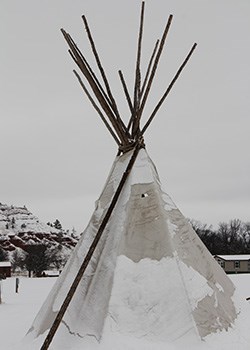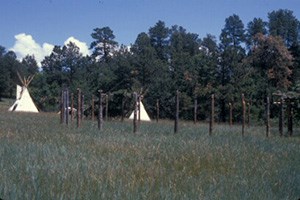|
To return to more pages about the history and culture of Devils Tower National Monument, use the links below: Affiliated Tribes The following peoples have geographical, historical and/or cultural ties to the Tower: Aside from the Kiowa, all of these tribes are considered Northern Plains Tribes. All six of these groups lived in or near the region known today as the Black Hills. The Tower is situated in the northwest corner of this region. In addition to, or inclusive with, the six groups listed above, there are over two dozen individual tribes affiliated with the Tower.

NPS photo Cultural and Spiritual Connections The connections which tie American Indian culture to the place known as Devils Tower are both ancient and modern. Oral histories and sacred narratives explain not only the creation of the Tower, but also its significance to American Indians. They detail peoples' relationships with the natural world, and establish those relationships through literal and symbolic language. Today there are several sources one can reference to read the various oral histories. 2 Modern connections are maintained through personal and group ceremonies. Sweat lodges, sun dances, and others are still practiced at the monument today.1 The most common ritual that takes place at the Tower are prayer offerings. Colorful cloths or bundles are placed near the Tower - commonly seen along the park's trails - and represent a personal connection to the site. They are similar to ceremonial objects from other religions, and may represent a person making an offering, a request, or simply in remembrance of a person or place. As with many religious ceremonies, they are a private to the individual or group. Please do not touch, disturb or remove prayer cloths or other religious artifacts at the park. It is important to note a key difference between American Indian religions and many other contemporary religions (referred to as "western" or "near eastern" religions): a sense of place dominates the religion of American Indians, as opposed to the sense of time that dominates many western religions. Instead of a focus of chronological events and the order in which they are presented, American Indian religion focuses on a place and the significant events that are connected with that location. Although western religions have their important places, they do not hold the level of sacredness associated with the important places of American Indian religions. 
NPS photo Tribal Connections Many of the tribes below have a sacred narrative, or oral history, about the creation of the Tower. You can read some of these oral histories on our park website. Arapahoes call Devils Tower "Bear's Tipi." 1 Sherman Sage, an Arapahoe, said that his grandfather, Drying-Up-Hide, was buried near the Tower.2 The Cheyenne call Devils Tower "Bear's Lodge," "Bear's House," "Bear's Tipi," and "Bear Peak."1 The Cheyenne camped and hunted at Bear's Lodge in the winter and consider it a holy place.2 "A band of Cheyenne Indians went on one of its visits to 'Bear's Tipi' to worship the Great Spirit, as did many other tribes before the white man came. The Cheyenne braves took their families with them as they felt that would be safe, as Bear's Tipi was a holy place."2 Devils Tower is where Sweet Medicine died and it is his final earthly resting place. Sweet Medicine is the great culture hero of the Cheyenne who brought the Four Sacred Arrows to the tribe. The Four Sacred Arrows' sanctuary was located within a secret cave on the south side of Bear's Lodge.1 Sweet Medicine also founded the Cheyenne Warrior Societies, tribal government, special laws, and ceremonies. As Sweet Medicine lay dying in a hut by Bear's Lodge, he foretold a dark prophecy of the coming of the horse;the disappearance of the old ways and the buffalo, to be replaced by slick animals with split hoofs the people must learn to eat (cattle). He told of the coming of white men, strangers called Earth Men who could fly above the earth, take thunder from light, and dig up the earth and drain it until it was dead.2 The Crow call Devils Tower "Bear Lodge." 1 The Crow people were known to fast and worship at Devils Tower and built small stone "dream houses" there as part of these vision quests. The stone dream houses were about as long as a man is tall. A man would recline inside with his head to the east and feet to the west, "like the rising and setting sun."2 The Kiowa call Devils Tower "Aloft on a Rock" and "Tree Rock." The oral histories of the Kiowa people link Tree Rock with their astronomical knowledge.1 "...origin memories of American Indian people reveal none anywhere 'as bright- and remote-' as the Kiowas memories of their days in the Black Hills and at Devils Tower."2 The Lakota people call Devils Tower "Bear Lodge," "Bear Lodge Butte," "Grizzly Bear's Lodge," "Mythic-owl Mountain," "Grey Horn Butte," and "Ghost Mountain." 1 Of the may tribes associated with the Tower, the Lakotas arguably have the strongest connections (or at least the most well-documented). The Lakotas often had winter camps at Devils Tower, documented as far back as 1816. Lakotas have an ancient and sacred relationship with the Black Hills, including Bear Lodge and Inyan Kara. The Black Hills are the Lakotas' place of creation.1 A Sioux legend tells of a Lakota band camped in the forest at the foot of Bear Lodge. They were attacked by a band of Crow. With the assistance of a huge bear, the Lakota were able to defeat the Crow.2 At Devils Tower, they fasted, prayed, left offerings, worshipped the "Great Mystery" (the essence of Lakota spiritual and religious life), and performed sweatlodge ceremonies. Lakota pray for health, welfare, and personal direction.1 The healing ceremony is known to have been performed at Bear Lodge, conducted by a healing shaman. The Great Bear, Hu Numpa, imparted the sacred language and ceremonies of healing to Lakota shamans at Bear Lodge. In this way, Devils Tower is considered the birthplace of wisdom.1 "White Bull told of 'honor men' among the people who went up close to Devils Tower for four-day periods, fasting and praying. There they slept on beds of sagebrush, taking no food or water during this time. Once, five great Sioux leaders-Sitting Bull, Crazy Horse, Red Cloud, Gall, and Spotted Tail-went there together to worship. We did not worship the butte, but worshipped our God."2 Vision quests are a very intense form of prayer requiring much preparation, fasting, purification rite (sweatlodge/inipi), and solitude.1 It is a ritual integral to the construction of Lakota identity. In addition to learning lore and moral teachings, individuals who seek visions "often regain clarity of purpose in their lives and a secure identity as a member of their tribe." Men and women may seek a vision for a variety of reasons: to give thanks, to ask for spiritual guidance, or simply to pray in solitude.3 One of Devils Tower National Monument's archaeological sites, assessed by archaeologist Bruce Jones in 1991, is a post-1930's shelter made of stone and wood which could have been used for vision quests. A Lakota legend tells of a warrior undergoing a vision quest at the base of Bear Lodge for two days. Suddenly, he found himself on the summit. He was frightened since he did not know how to get back down. After praying to the Great Spirit for assistance he fell asleep. Upon awakening, he found himself back down from the butte.2 The Lakotas traditionally held their sacred Sun Dance at Devils Tower around the summer solstice. The Belle Fourche River was known to the Lakotas as the Sun Dance River.1 Bear Lodge is considered a sacred place of renewal. The Sun Dance is a ceremony of fasting and sacrifice that leads to the renewal of the individual and the group as a whole. The Sun Dance takes away the pain of the universe or damage to Nature. The participant suffers so that Nature stops suffering. The Sun Dance is "...the supreme rite of sacrifice for the society as a whole [and] a declaration of individual bravery and fortitude... Young men went through the Sun Dance annually to demonstrate their bravery as though they themselves had been captured and tortured, finally struggling to obtain their freedom."3 The tearing of the pierced flesh is symbolic of obtaining freedom and renewal. NPS records indicate that modern Sun Dance ceremonies have been held at Devils Tower since 1983. The Lakotas also received the White Buffalo Calf Pipe, the most sacred object of the Lakota people, at Bear Lodge by White Buffalo Calf Woman, a legendary spiritual being. The sacred pipe's sanctuary was located within a secret cave on the north side of Bear Lodge.1 In 1875, General George A. Custer swore by the pipe that he would not fight Indians again. "He who swears by the pipe and breaks oaths, comes to destruction, and his whole family dies, or sickness comes upon them."3 Pipes often are held as sacred objects used in vision quests, Sun Dances, sweatlodge rites, and in making peace. The Eastern (Plains) Shoshone claim to have a sacred association with Devils Tower. Their religious world, however, is kept very secret and, as a result, cannot be documented at this time. References
|
Last updated: April 24, 2025
